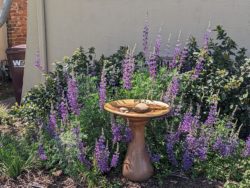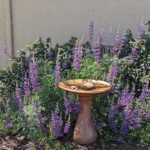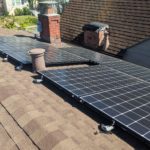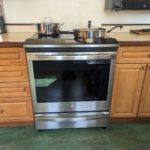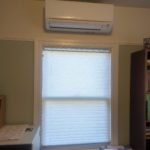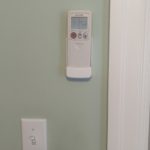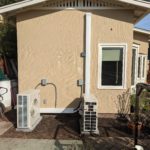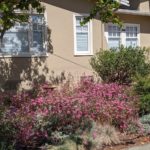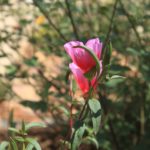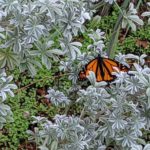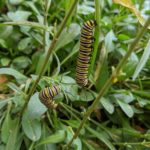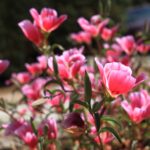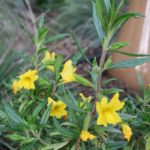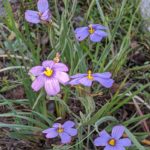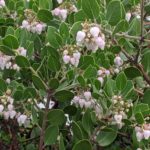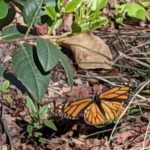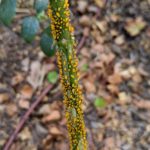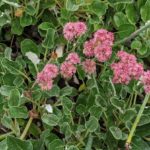Lot size: 500 sq. ft. front garden, 100 sq. ft. parking strip 95% native
Garden Age: Garden was installed in the spring of 2017
Years on the Bringing Back the Natives Garden Tour:
Showcase Feature
Sue read Douglas Tallamy’s charming NY Times Op Ed piece, “The Chickadee’s Guide to Gardening: In Your Garden Choose Plants That Help the Environment,” and knew that she wanted a native plant garden that would provide food, shelter, and nesting areas for birds, bees, and butterflies.
But there were challenges to overcome—starting with an infestation of Bermuda grass, which was followed by the task of finding diminutive plants that would be of an appropriate scale in her small garden, and that could also tolerate unexpected visits by children and balls.
More than $1,000 in rebates from the East Bay Municipal Utility District and Save Our Water helped pay to have the Bermuda grass dug out, the lawn sheet mulched, and a drip system and plants purchased. After receiving consultations from a couple of native plant garden designers, Sue and her husband purchased the plants and installed the plants and drip system.
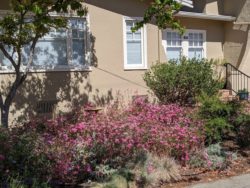 The garden has evolved considerably since it was installed, and Sue reports its evolution has been “a wonderful learning experience.” Many plants grew rapidly and much larger than expected. Neighborhood children, dogs, and deer were hard on the brittle plants. Drought led to the death of several plants, including a beautiful ‘Austin Griffiths’ manzanita, which was replaced.
The garden has evolved considerably since it was installed, and Sue reports its evolution has been “a wonderful learning experience.” Many plants grew rapidly and much larger than expected. Neighborhood children, dogs, and deer were hard on the brittle plants. Drought led to the death of several plants, including a beautiful ‘Austin Griffiths’ manzanita, which was replaced.
Sue has kept a notebook of plants she tried, what has worked, and what hasn’t. The current challenge is how to manage plants that reseed and spread readily, within the confines of her small space. Ask her about these dilemmas, or any other aspect of the creation of this charming garden.
Other Garden Attractions
• In addition to native plants, Sue and her husband, Mark’s, other gardening interest is growing food. You are welcome to visit the backyard, which has numerous fruit trees and other fruits and vegetables.
• No pesticides are used in this—or any!—Tour garden.
• A restroom is available; you may enter the house through the back garden.
Gardening for Wildlife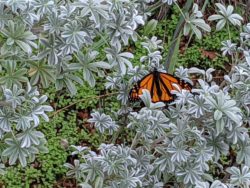
Our own local narrow leaf native milkweed, Asclepias fascicularis, has attracted monarch butterflies, which now lay their eggs in the garden, and flutter about, sipping nectar from the many native plants in the garden. (Milkweed is the only plant that monarchs can lay their eggs on; planting narrow leaf milkweed in your own garden will help this endangered species.)
Manzanita provide nectar to hummingbirds and native bees in the winter and early spring; later in the year other birds visit the manzanita for seeds and fruit. Adding a bird bath greatly increased the number of birds that visit. In summer clarkia brighten the garden with their bright pink blossoms, while also attracting native bees. The long, tubular blossoms on the penstemon and monkeyflower invite visits from hummingbirds. The beautiful perennial seaside daisy and two types of buckwheat are great butterfly plants.
Green Home Features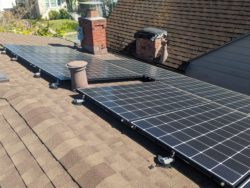
Come on in and check out the green features in this house! Volunteers will be on hand to answer your electrification questions.
Sue and her husband had a 2.5 KW solar panel system installed in January of 2017. They hope to install additional panels in the future.
In spring of 2022 Sue and her husband, Mark, replaced two gas furnaces with two Mitsubishi heat pump systems.
A small ducted system was installed in the 1996 addition, which is located in the back of the house. A larger system heats and cools the original 1925 house, and includes both a ducted system that heats and cools the downstairs, and also two ductless mini splits upstairs, which allow them to minimize heating and cooling in this split-level house.
Outdoors you can see the two compressors and the line sets, which take refrigerant to the air handlers and the 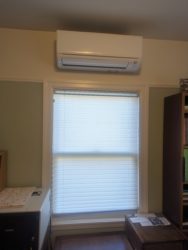 mini splits. Inside you can see the registers for the ducted system in the kitchen and dining room, which are on the ground floor. Head upstairs to the office to see one of the ductless mini splits in the office.
mini splits. Inside you can see the registers for the ducted system in the kitchen and dining room, which are on the ground floor. Head upstairs to the office to see one of the ductless mini splits in the office.
Sue reports, “The heat coming out of the registers is much cooler than the hot air from the gas furnace was; we find it very comfortable. The hardest part of the project was working with Albany’s building codes to find a location for the outdoor compressors.” The compressors can be seen (and heard) in the back yard.
In summer of 2022 Sue and Mark replaced their gas stove with a GE Profile electric induction stove. Sue says, “I am sensitive to air pollution and am thrilled at how much cleaner the air in the kitchen is when I am cooking!”
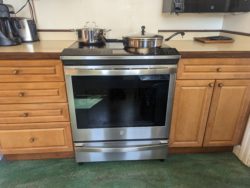 Come on into the kitchen to see the stove, and their Tramontina and Farberware New Generation pots and pans.
Come on into the kitchen to see the stove, and their Tramontina and Farberware New Generation pots and pans.
To support the additional electric use, the electric service was upgraded from 100 to 220 amps. Sue noted, “PG&E is much more safety conscious now than it used to be. The configuration of our 1986 electric panel, our 2017 solar control panels, and our 1925 gas service is no longer considered safe. We put the new electric panel on the other side of the house. This all turned out to be much more expensive than we expected.”
Sue and Mark still have a tankless gas water heater, their only remaining gas appliance. With PG&E’s help they were able to disconnect all of the other gas pipes. They are looking forward to switching to all electric in the future.
Ask Sue and Mark about their electrification efforts!
Green Home Features Fact Sheet
Parking
Parking will be tight. Please do not block the neighbors’ driveways.


